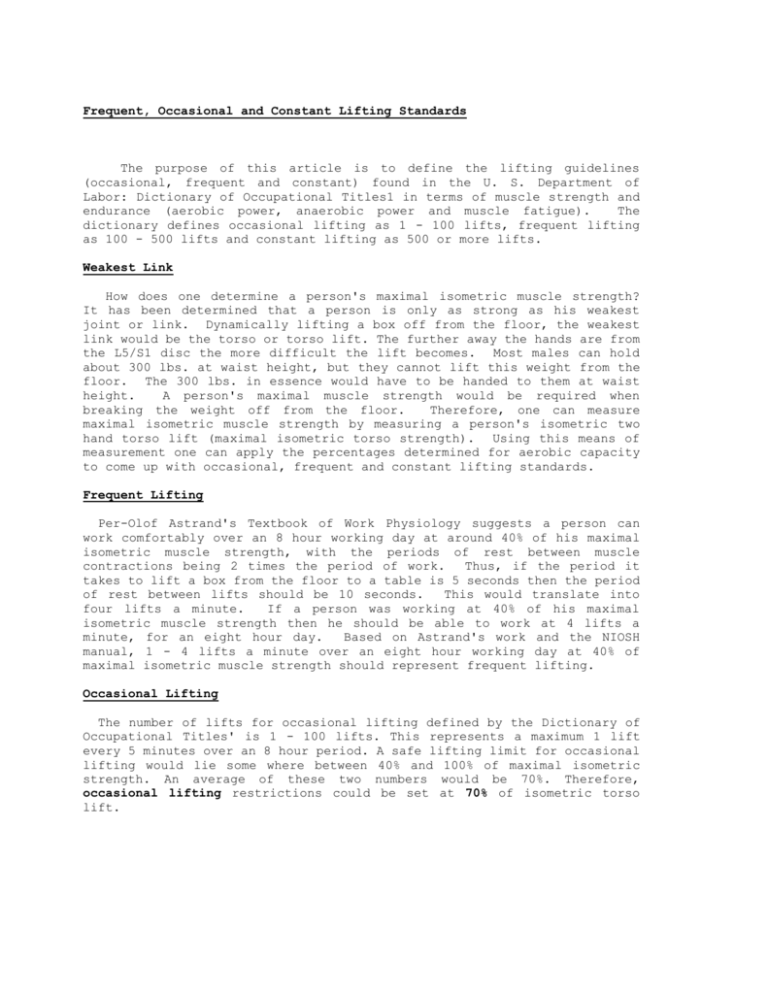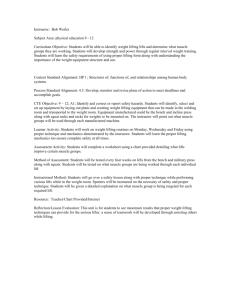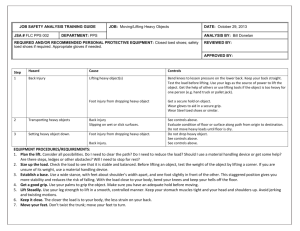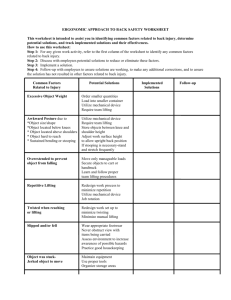Occasional, Frequent and Constant Lifting Standards
advertisement

Frequent, Occasional and Constant Lifting Standards The purpose of this article is to define the lifting guidelines (occasional, frequent and constant) found in the U. S. Department of Labor: Dictionary of Occupational Titles1 in terms of muscle strength and endurance (aerobic power, anaerobic power and muscle fatigue). The dictionary defines occasional lifting as 1 - 100 lifts, frequent lifting as 100 - 500 lifts and constant lifting as 500 or more lifts. Weakest Link How does one determine a person's maximal isometric muscle strength? It has been determined that a person is only as strong as his weakest joint or link. Dynamically lifting a box off from the floor, the weakest link would be the torso or torso lift. The further away the hands are from the L5/S1 disc the more difficult the lift becomes. Most males can hold about 300 lbs. at waist height, but they cannot lift this weight from the floor. The 300 lbs. in essence would have to be handed to them at waist height. A person's maximal muscle strength would be required when breaking the weight off from the floor. Therefore, one can measure maximal isometric muscle strength by measuring a person's isometric two hand torso lift (maximal isometric torso strength). Using this means of measurement one can apply the percentages determined for aerobic capacity to come up with occasional, frequent and constant lifting standards. Frequent Lifting Per-Olof Astrand's Textbook of Work Physiology suggests a person can work comfortably over an 8 hour working day at around 40% of his maximal isometric muscle strength, with the periods of rest between muscle contractions being 2 times the period of work. Thus, if the period it takes to lift a box from the floor to a table is 5 seconds then the period of rest between lifts should be 10 seconds. This would translate into four lifts a minute. If a person was working at 40% of his maximal isometric muscle strength then he should be able to work at 4 lifts a minute, for an eight hour day. Based on Astrand's work and the NIOSH manual, 1 - 4 lifts a minute over an eight hour working day at 40% of maximal isometric muscle strength should represent frequent lifting. Occasional Lifting The number of lifts for occasional lifting defined by the Dictionary of Occupational Titles' is 1 - 100 lifts. This represents a maximum 1 lift every 5 minutes over an 8 hour period. A safe lifting limit for occasional lifting would lie some where between 40% and 100% of maximal isometric strength. An average of these two numbers would be 70%. Therefore, occasional lifting restrictions could be set at 70% of isometric torso lift. Constant Lifting On page 64 of the NIOSH manual, The Work Practices Guide for Manual Lifting, reference is made to continuous (8 hours) lifting expenditure rates as being 5 Kcal/minutes for a physically fit male. In an article written by Garg, Chaffin and Herrin ("Prediction of Metabolic Rates for Manual Materials Handling Jobs") it is stated that 16 Kcal/minutes is usually considered the maximum aerobic power for a healthy male. Dividing 5 Kcal/minutes by 16 Kcal/minutes would give us 31% of aerobic capacity for continuous lifting. The same ratio proportional adjusted for females produces the same result 31%. The formula derived from the NIOSH manual for the aerobic capacity for constant lifting which was determined to be 31%. The number of lifts for constant lifting defined by the Dictionary of Occupational Titles' is 500 or more lifts. This represents 5 or more lifts every minute over an eight hour period. Combining the definitions for constant lifting in the NIOSH manual and the Dictionary of Occupational Titles and following Per-Olof Astrand's rationale, a person working at 31% of his maximal muscle strength would be able to work at a rate of 5 lifts or more every minute over an 8 hour period. Therefore, 5 lifts or more every minute over an 8 hour working day at 31% of maximal isometric torso strength would represent continuous lifting. References 1) U.S. Department of Labor: Dictionary of Occupational Titles, Fourth Edition Supplement, Appendix D pp. 101-102, 1986. 2) U.S. Department of Health and Human Services: Work Practices Guide for Manual Lifting, Page 64, March 1981. 3) Garg, Chaffin and Herrin: "Prediction of Metabolic Rates for Manual Material Handling Jobs", American Industrial Hygiene Association Journal, August, 1977. 4) Astrand, Per-Olof and Rodahl, Kaare: Textbook of Work Physiology, Third Edition, Chapter 11 pp. 501 - 502, 1986. 5) Chaffin & Andersson: Chapter 4, page 119, 1990. Occupational Biomechanics, Second Edition, 6) American Medical Association: Guides to the Evaluation of Permanent Impairment, Third Edition (Revised), Chapter 5 page 122, 1990





